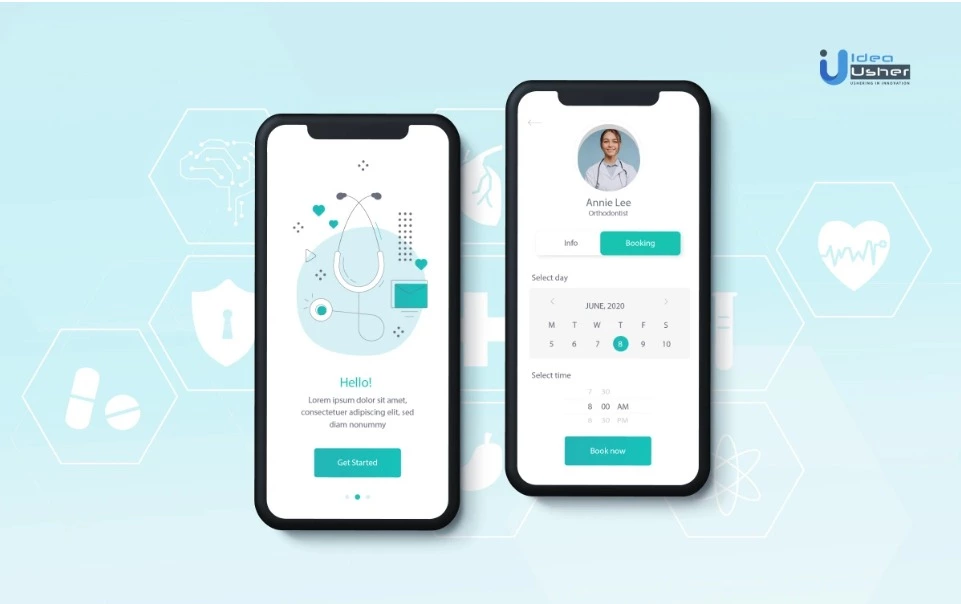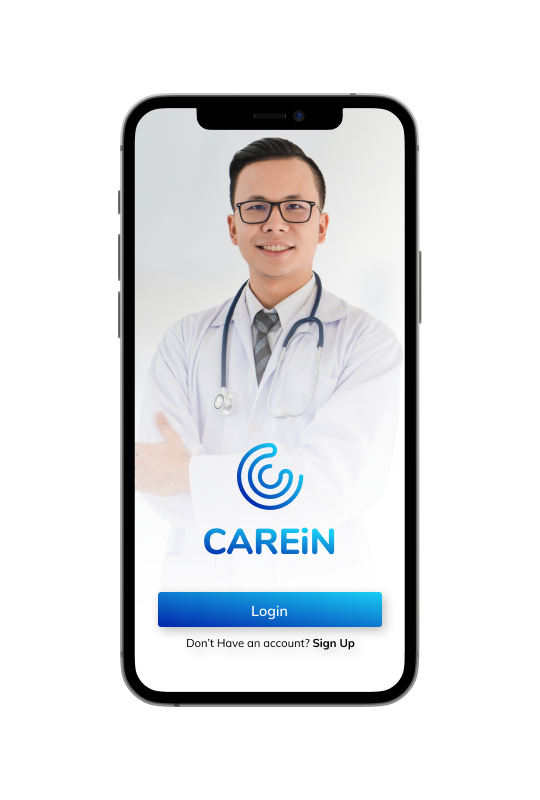There is an alarming shortfall of doctors in the USA. As per the report, there will be a shortage of physicians, with an estimated availability of 15 psychiatrists and 30 psychologists per 100K people.
The lack of healthcare specialists offers an excellent opportunity for telemedicine apps. The apps can provide a digital platform for patients and doctors and make a meaningful impact on the masses.
Here in this blog, we will cover everything from essential features to required steps for telehealth app development.
What is Telehealth App?

The apps provide a digital platform for healthcare providers and patients. Patients can interact with physicians anytime and anywhere. The app enables healthcare professionals to diagnose and treat patients for various appointment types, including consultations and follow-up routines.
Telehealth apps have simplified the way patients can access healthcare services. Now patients don’t need to sit in waiting rooms for hours to get medical consultations from doctors.
Telehealth App Types
The apps can be built to serve different purposes. The most common types of telehealth apps are as follows:
1. Real-time Interaction
The app enables healthcare providers and patients to interact through audio/video conferencing. Real-time interaction enables doctors to provide live treatments to patients.
2. Remote Monitoring
Remote monitoring apps allow doctors to track patients’ data virtually through IoT-enabled and wearable devices to offer them medications and disease-related treatments.
3. Store-and-forward
Doctors can store patients’ data, such as blood tests, lab reports, videos, and imaging studies, to examine their health conditions and forward them to others, such as radiologists, physicians, or other specialists.
Now, let’s look at popular trends in the healthcare industry.
Trends In the Telehealth Industry
Virtual healthcare is no longer the preference for only millennials.
The COVID-19 pandemic has impacted healthcare services on a massive scale. Almost everyone prefers healthcare services from their desktop and mobile devices to access fast and safe healthcare services.
Let’s explore the trends that are shaping the telemedicine industry today.
1. Market Overview
The latest report from CB Insight states a 300% increase in investment in every aspect of the healthcare industry, including remote patient monitoring, consultations, and health education services. Etc.
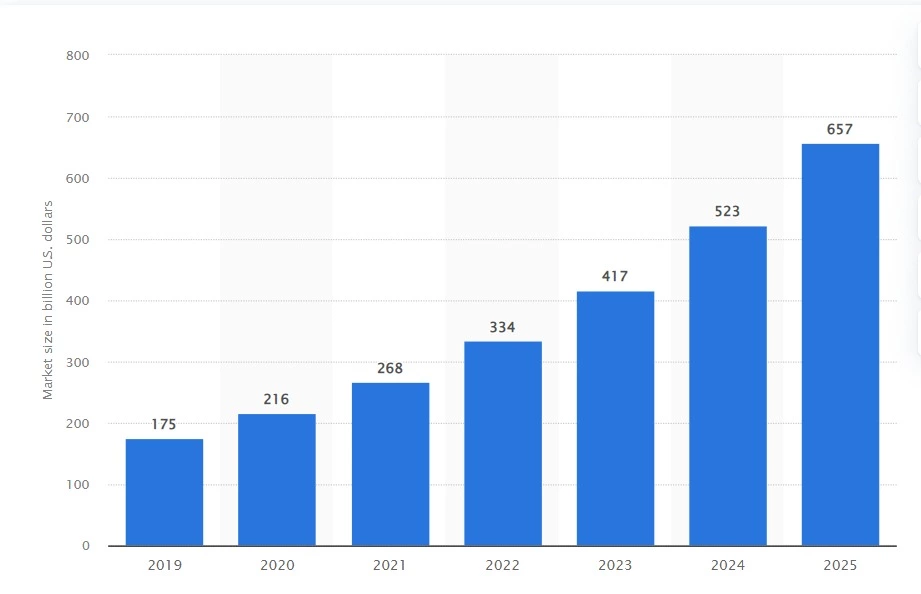
Source: Statista
According to the report, telemedicine will reach $657B by 2025.
2. Growing demand for telemedicine apps
A vast population will rely on telemedicine. Seniors with chronic diseases would need to access telemedicine solutions without leaving the comfort of their homes.
3. Vertical growth across the industry
The industry is expanding beyond e-consultation with physicians. Telehealth is growing across broad niches, including telenursing apps, teledermatology apps, online healthcare consultations, etc.
4. Better insurance coverage
The medical industry covers many types of telemedicine services and remote patient monitoring.
Many insurance companies and federal health programs are preparing to integrate their services with popular telemedicine and healthcare platforms. While some companies are aiming to create their platform for offering healthcare insurance.
5. Remote patient monitoring
Doctors can monitor their patient’s health records and provide remote treatments based on their medical condition. The most common healthcare data for remote patient monitoring includes body weight, blood pressure, and heart rate.
6. AI applications in healthcare apps
The technology can assist medical professionals by making precautions and plans for patients’ well-being. Professionals can analyze patients’ healthcare data with detailed analytics by leveraging the power of AI. You can hire AI developers to enhance your app experience even further.
Benefits Of Telemedicine Apps
Telemedicine app eliminates the waiting period for patients giving them access to healthcare professionals. The patients can access physicians from all over the country. Moreover, there are many benefits to having an app.
Healthcare app offers the following advantages:
1. Patient Benefits
- Access to healthcare professionals on demand
- There is no need to visit a clinic.
- Service at a lower cost
- Simpleness of usage (accessible on any device)
2. Provider Benefits
- The ability to work on patient cases with remote colleagues.
- Patients who have been released and have access to home care
- Capability to treat several patients at the same time
- EHR and other clinical systems integration
- Fewer appointment cancellations and no-shows
Top Successful Telehealth Companies
Explore the best platforms in the telehealth industry.
1. Doctor On Demand
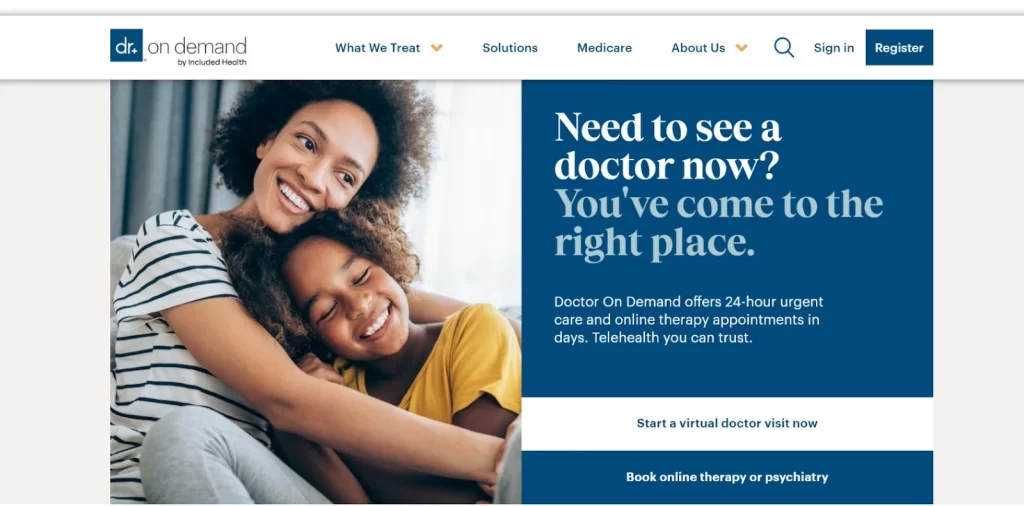
The platform connects patients with various healthcare professionals. On this platform, patients can access various healthcare services such as mental health, allergies, colds and flu, skin conditions, etc. Moreover, the app also enables patients to schedule a video appointment from their phones and tablets.
Top features:
- Upfront pricing
- Medication management
- Healthkit and Google Fit integration
- Push notifications
- Video calls
| Founded in | 2012 |
| Available on | Android & iOS |
| Headquarters | San Francisco, USA |
| App downloads | 1M |
| App ratings | 4.8 |
2. MDLIVE
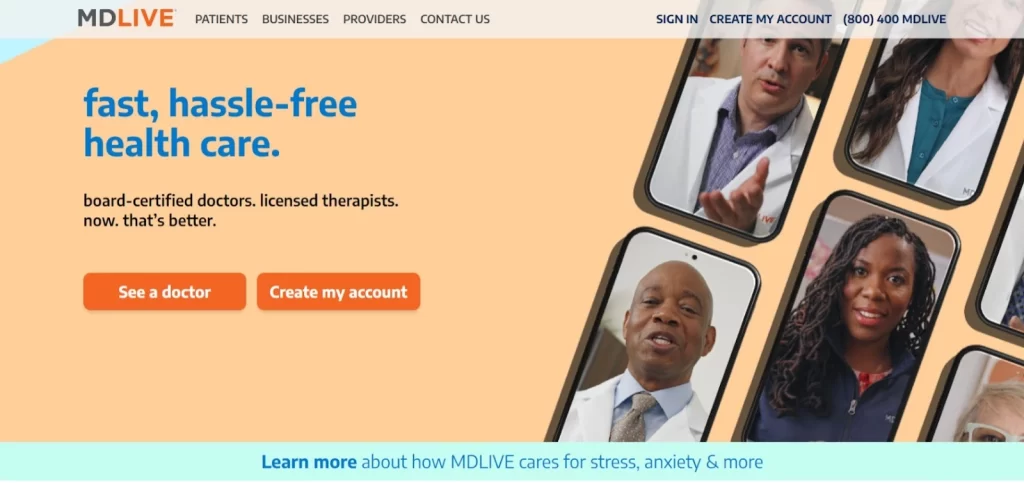
Founded in 2009, MDLIVE is a leading player in the telemedicine market, offering healthcare services across major categories such as primary care, urgent care, dermatology, mental health therapy, and much more.
Top features:
- ePrescribe integration
- Video calls
- Health records
- Instant messaging
- Mobile payments
| Founded in | 2009 |
| Available on | Android & iOS |
| Headquarters | Florida, USA |
| App downloads | 500K |
| App ratings | 4.7 |
3. Teladoc
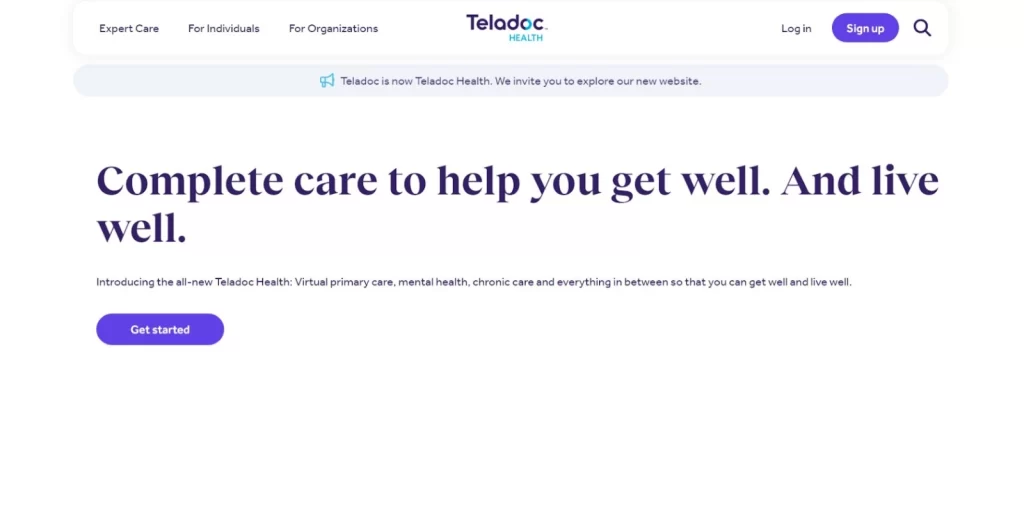
The app provides connectivity for patients to the most qualified doctors, where they can access a wide range of healthcare services. Teladoc integrates with Apple Healthkit enabling users to upload their most recent health condition.
Top features:
- Scheduling a meeting
- Medical history
- Mobile payments
- Video and audio calls
- Integration with Healthkit and Google Fit
| Founded in | 2002 |
| Available on | Android & iOS |
| Headquarters | New York, USA |
| App downloads | 1M |
| App ratings | 4.1 |
4. Better Help
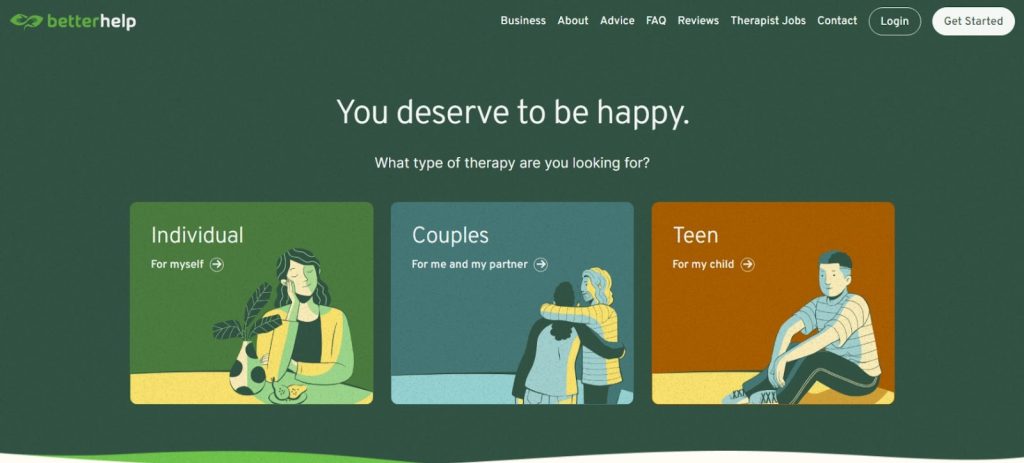
The app provides instant access to choose from almost 3000 qualified mental health specialists and counselors. From anxiety to depression, “Better Help” treats almost every mental health issue.
With its monthly subscriptions, users can access weekly live sessions from their doctors.
Top features:
- Group therapy
- Scheduled live chats
- Calling from an unknown number
- Live video conferences
| Founded in | 2012 |
| Available on | Android & iOS |
| Headquarters | California, USA |
| App downloads | 1M |
| App ratings | 4.6 |
Challenges In Developing Telehealth Apps
There are some challenges with creating telemedicine apps that developers and healthcare providers should be aware of and overcome.
1. Data Security
Everyone wants their details to be safe and secure, and the same is for patients. Creating apps involves challenges for app developers to ensure the safety and security of the data of patients and healthcare providers.
App developers can overcome the challenge by enabling encrypted data transmission and complying with rules & regulations.
2. Compliance With Healthcare Legislation
One of the most common challenges developers face when they create healthcare apps. Laws related to data collection, storage, and processing must be subjected to rules and regulations for different regions.
Ensure the app is HIPAA compliant within the U.S. region you have chosen for app publication. However, working with the most trustable app development companies can help your app comply with necessary healthcare legislation.
The other required compliance are as follows:
- HIPAA
- FDA
- BYOD
- GDPR
- HL7
You can understand the above compliances in detail.
3. Language Barrier
Most people don’t have a perfect command of English. Not having English proficiency can negatively impact their ability to access healthcare services from mobile apps.
Such patients would not be able to explain their health conditions and symptoms to healthcare professionals accurately. However, real-time language transitions exist nowadays that you can implement into your app by hiring skilled mobile app developers.
Required Functions For Telemedicine Apps
To have a telemedicine app, you must have the following basic features. You can start with a minimal viable product (MVP) or continue with a fully-fledged telemedicine app.
1. MVP feature set
The MVP version of the telemedicine app provides users with essential features that make an app fully functional and ready to use.
2. Video calling
Patients and healthcare providers need real-time interaction with each other through video calling. Healthcare providers can better identify signs of illness in their patients much better by leveraging the functionality of video calling.
3. Peer-To-Peer chat
Patients and healthcare providers need real-time interaction with each other through video calling. Healthcare providers can identify signs of illness in their patients much better by leveraging the functionality of video calling.
4. Backend database
Enable your app users to store and access their crucial healthcare data. You will need a safe repository for data and access, such as patient information, labs, medical history, imaging, etc.
5. Appointment scheduling
Enable your app users to store and access their crucial healthcare data. You will need a safe repository for data storage and access, such as patient information, labs, medical history, imaging, etc.
Telemedicine App: Advanced Feature Set
Beyond MVP, you may need to add advanced features to enhance the experience of your telemedicine app even further. Explore the following advanced features for your app.
1. Group chats and calls
Allow your patients and healthcare providers to interact in groups by enabling the functionality of group chats and calls. Doctors can host health consultation calls for patients using group chats and calls.
2. Integration with EHR
Accurate patient history is necessary for any healthcare organization. Being able to sync patients to an EHR system can help save a lot of time for medical professionals.
3. VR for telepsychiatry
Establishing trust between specialties and patients can enhance a platform experience for your telemedicine app.
4. E-Prescriptions
Incorporate an e-prescription component to your telehealth app to enable healthcare providers to help their patients.
5. Mobile payments
Integrate a payment gateway to your telemedicine app to allow patients to pay for the services straight from your app. However, many apps can implement this functionality via a web view to bypass Apple/Google commissions.
6. Integration with IoT devices
Integrating IoT devices will enable healthcare providers to acces their patients’ healthcare data through sensor-based gadgets such as wearables, teledentistry, etc.
7. Integration with Healthkit and GoogleFit
Enable healthcare providers on your app to better access patients’ health conditions by integrating Apple’s Heatlkit and GoogleFit. These services offer patients’ health data helping healthcare providers to understand their medical conditions better.
8. Built-in chatbot
Sometimes, new app users may need help scheduling appointments or other purposes. Help your app users to resolve their basic queries by integrating chatbot functionality into your app.
9. Module for medical assistants
Many best telemedicine apps offer a separate UI with exclusive app features for nurses and other medical professionals. Offering individual panels for different healthcare professionals will help them to access relevant features that are provided by your app.
Tech Stack For Telemedicine App Development
The recommended tech stack for telemedicine app development is as follows:
| Android | Java, Kotlin, Android Studio, Jetpack Compose, Android UI (template) |
| iOS | Objective-C, Swift, XCode, AppCode, UIKit, SwiftUI |
| Cross-platform | React Native(JS), Flutter(Dart), Xamarin(C#) |
| Server | Amazon EC2, Amazon EKS / AWS Lambda |
| Storage | Amazon S3 |
| Database provider | Amazon RDS, Amazon DynamoDB |
| Messaging queues | Amazon SQS |
| Push notifications | Firebase notifications |
| API server | Node.JS |
Steps To Start Telemedicine App Development
Follow the given steps to create your app.
STEP 1: Choose a platform
Whether you are building a fitness app or a meditation app, you need to decide the platform where you want to publish your apps, such as mobiles, desktops, or the web.
The targeted geography will also help you decide on the platform for your app. If you are targeting the USA audience, then consider iOS only approach.
While Android’s first approach will be best if you are targeting other countries as well.
Choose between iOS Or Android
If you are targeting the USA audience, then you should go with iPhone devices. As per data, the iPhone makes up 55% of the total smartphone user base, while Android remains 45%.
It has been found that iOS users are known to spend up to three times more than Android users. However, if you want to target both devices, then we suggest you go with Hybrid app development by choosing React Native or Flutter for a telemedicine app development.
For Desktop: Native Or Web?
You can offer additional features to web apps that physicians can use to manage their workflows and patient files. Users who don’t have Android or iOS mobile devices can also go for a desktop app to access healthcare services.
The cost of building a web and a native app is almost the same.
Moreover, the web app can be converted into a native desktop app that works on operating systems like Mac, Windows, Linux, and others.
Choosing between SAAS And Custom Build
When comparing SaaS with a custom build app, the difference is clear.
With a custom build, you will get more freedom to customize and personalize your telehealth app as per your business needs.
Moreover, you will get a great level of freedom to personalize the look and functionality of your app.
Is SaaS more economical than a custom build?
SaaS involves no programming, making it ready to deploy in no time. It comes with monthly subscription fees, which can be adjusted based on user volumes.
Initially, SaaS may be an economical option, but later it can become more expensive when user volume outgrows the capabilities of your SaaS product. Also, you have no control over the features and updates provided by an app made with a SaaS solution.
Custom app development may be expensive in the short term, but it can give more returns to your business, such as personalized app development and business solutions.
STEP 2: Start Designing Telehealth App
The stage involves creating the UI of your application.
User Experience Design
The user experience design is another critical aspect of healthcare app development. Even with the best business ideas, many entrepreneurs fail in their business apps because of poor user experience.
The UX design stage is where poor app UI can be prevented by implementing essential designing practices.
You can follow the best app designing practices, such as:
- Limiting the number of onboarding screens to upto three
- Copy’s language must be plain and simple
- Simple and easy-to-use user interface
- Proper app navigation where users can easily access all the app features
After creating the UX wireframe for your app, UI design will be the next stage of your app development.
User Interface Design
User interface design is the stage where app developers will add colors, buttons, fonts, and all other visual aspects of the app. You can test different colors and button sizes for your app.
Later the app’s UI will be converted into a prototype to test the app’s features and functionality.
STEP 3: Choose Suitable APIs For Your App
Building an app without market-ready API can extend the development stage of your app up to 1-2 years. However, with the proper selection of API, the telehealth app can be built in 3-6 months. Let’s look at the leading APIs:
VSEE SDK
VSee SDK offers end-to-end encrypted video calls and integrates with mobile devices such as iOS and Android and desktops like Mac and Windows.
The SDK is HIPPA compliant that has its server-client helping developers to reduce the workload and to allow them to focus more on user experience and design interface.
The only drawback here is it is not open source, and there is the involvement of a significant cost barrier to getting the customizable codebase that can go up to $20,000.
VIDYO
The API allows you to integrate real-time communication capabilities on your app. You can integrate the API with multiple platforms, including iOS, Android, Windows, Linux, and Mac.
VIDYO has an inbuilt text chat that supports video calls for group video conferencing. However, the API is not an open-source product and only allows minimal customization.
WEBRTC
An open-source platform that enables real-time communication on the web and native apps. The WebRTC enables the transmission of audio, video, and data and supports web browsers like Firefox, Chrome, and Opera.
Moreover, native support is available for iOS and Android except for desktop operating systems like macOS and Windows.
OPENTOK
The API is an open-source WebRTC platform that has extreme customization potential. The platform is developed by Vonage, which allows you to integrate features such as text, video, audio messaging, and screen sharing.
The API supports HIPPA-complaint app development and can be integrated with the web, Windows, Android & iOS, except for macOS.
Twilio
The API offers features such as SMS, messaging, text chat, video calls, and emails. Twilio works on all browsers, including mobile devices such as iOS and Android, and can be instantly scaled from starters to enterprises.
Acuity
The API is designed to support the healthcare industry’s needs, such as HIPAA compliance. Acuity helps app owners to schedule anything from payments to reminders.
How Do You Select The Right APIs?
The selection of API will depend on the app’s features, platform, and other aspects, such as API selection will be different for native and hybrid app development.
STEP 4: Test Your Telemedicine App
We can’t underestimate the importance of app testing. Flawlessly working on your app is a huge milestone when starting telehealth app development.
You can ask app developers to execute peer code reviews, plan for quality assurance and regression testing, and cover everything important during app testing.
Moreover, we recommend you perform stress testing before launching your app to your targeted market.
STEP 5: Deploy And Maintain Your App
iOS & Android devices come with new updates every year. However, it is essential to upgrade your app with new updates to enhance the experience of your app.
Are You Ready To Start Telehealth App Development?
Due to the high demand for telehealth apps, it’s the perfect time to build your custom app.
If you want to create your app. We are here to help. Our team will help you by analyzing your business needs and offering you custom solutions for your telehealth business.
At Idea Usher, we specialize in developing custom apps across different industries and platforms, such as mobile devices, desktops, and the web.
Also, to further enhance your platform experience, you can integrate top-demanding technologies such as blockchain, artificial intelligence, and IoT into your app by outsourcing your project to our team.
Explore our portfolio for the best apps across the telemedicine industry.
Contact Idea Usher
Email:
Phone:
FAQ
Q. What are the essential features of developing a telemedicine app?
A. You can add features to your apps such as MVP feature set, Secure video calling, Peer-To-Peer chat, Backend database, Appointment scheduling, Group chats and calls, Integration with EHR, VR for telepsychiatry, E-Prescriptions, Mobile Payments, Integration with IoT devices, Healthkit and GoogleFit, Built-in chatbot, and Module for medical assistants.
Q. How do I develop a telemedicine app?
A. You can create your app by first targeting the right market.
Next, you need to hire app developers. However, outsourcing will be the best option where the team will follow the app development process step by step, such as app strategy, frontend development, backend development, app testing, and app maintenance.
Q. Which of the following is a challenge associated with telehealth app development?
A. When developing applications for the telehealth industry, there are some associated challenges such as data security, language barrier, compliance with healthcare legislation, finding suitable app developers, etc.
Q. What are the different types of telemedicine?
A. The telemedicine industry has three types of apps: real-time interaction, remote monitoring, and store & forward apps.
